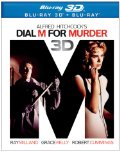| Reviews & Columns |
|
Reviews DVD TV on DVD Blu-ray 4K UHD International DVDs In Theaters Reviews by Studio Video Games Features Collector Series DVDs Easter Egg Database Interviews DVD Talk Radio Feature Articles Columns Anime Talk DVD Savant Horror DVDs The M.O.D. Squad Art House HD Talk Silent DVD
|
DVD Talk Forum |
|
|
| Resources |
|
DVD Price Search Customer Service #'s RCE Info Links |
|
Columns
|
|
|
Dial M for Murder
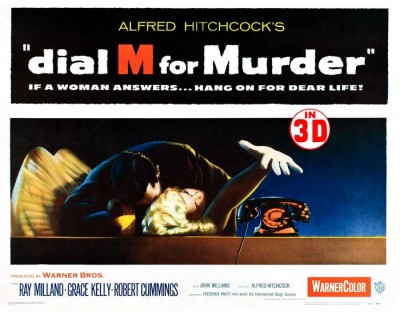
Dial M For Murder was Alfred Hitchcock's 39th film and based on a stage play by Frederick Knott. The story concerns Tony (Ray Milland) and his wife Margot (Grace Kelly). They live together in a London apartment (where most of the movie takes place) but the problem is that Margot has been having an affair with Mark (Robert Cummings) for quite some time. Tony has known about it but hasn't said anything, pretending everything is fine while secretly thinking of a way to get rid of her for good. He sees an opportunity to have an old friend named Charles (Anthony Dawson) help him with this. The plan is to let Charles get into the apartment while Margot is in bed and Tony is out with friends. After Charles has hidden in the living room, Tony plans to make a call home where the only phone is in the living room. When Margot comes out to answer it, Charles is to strangle her. Unfortunately this doesn't turn out as planned (to say much more would spoil the movie), and Tony now has to do some covering-up while the Chief Inspector from Scotland Yard (John Williams, no relation to the composer) investigates what happened.
Despite the title, the emphasis here is more on the subsequent investigation and cover-up than the murder itself- there is only one scene of violence. Hitchcock keeps up his reputation as "the Master of Suspense" as first-time viewers try to figure out how it will all turn out. Ray Milland is particularly smooth as he calculates his way through the aftermath of his perfect crime gone wrong with John Williams under his nose. Dial M For Murder is quite entertaining, and calls for repeat viewings to catch all the small details.
Picture: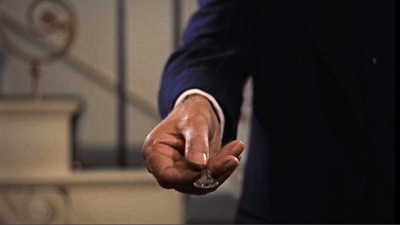
The main reason to celebrate this release is that this is the second "golden age" 3D movie of the 1950s to be released in the 3D Blu-Ray format (the first being Universal's Creature From the Black Lagoon which was only released separately in the UK, here it's part of the Universal Monsters Collection. Of course Paramount also released Hondo this year, dropping the ball by releasing that only in 2D.) Being a long-time 3D fan and having bought into previous attempts to show 3D movies at home, I've been very happy with the quality of the 3D Blu-Ray system so far but a bit puzzled at why it's been so slow for the 3D classics to come out. Dial M For Murder has been one of the 3D Holy Grails for a long time- it actually was available in the 80s in Japan on the VHD videodisc system (a third videodisc format that was also planned for release in the US but only made it out in Japan) which used the field-sequential format like that of the Sega Master System's 3D games and the 3D DVDs from Slingshot that came out a few years ago. (The 3D effect on these was good, but the resolution was halved and they will not work on modern HDTVs.)
So how is the 3D here? Well, I should say that it isn't at all used gratuitously like other 3D movies of the era. Nothing is pointed at the camera for the sole purpose of coming out of the screen, in fact there are only two shots in the entire movie (one shown above, and the other on the poster) that come close to this effect. The opening and closing credits do protrude a bit from the screen and look very good doing so, but those hoping for "stuff coming out of the screen" are going to be mostly disappointed. Since Dial M For Murder was based on a stage play, there really isn't a lot of "action" that really calls for this. I liken this to movies that use 5.1 sound mixes even though they consist primarily of dialogue with no explosions or anything like that- while it might not exactly grab you, it can still be used well for the material. There is definitely a great deal of depth throughout the movie. In fact, I noticed that I had to focus my eyes on objects in order to view the movie clearly, just staring straight at it resulted in double-images. Many of the older 3D movies I've seen have been like this, while it hasn't been as much in the recent crop (I personally like having to make my eyes 'work' a bit to see a 3D movie properly, but many do not). Many shots have prominent foreground objects with the actors behind them, for example in the conversation planning the murder a lamp in the room becomes the foreground object with the actors conversing behind it, which viewed in 2D (available as an option on the disc) doesn't really stand out but in 3D you feel like you're eavesdropping from BEHIND the lamp.
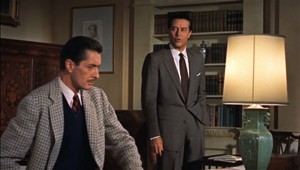
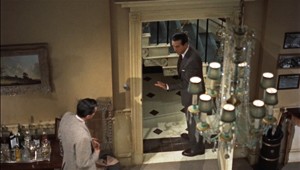
Although Dial M For Murder has been long regarded as one of the few 3D movies of the 1950s that was actually a good MOVIE (many such as Robot Monster were rushed low-budget productions with poor scripts and acting), it was also one of the last as by 1954 audiences and exhibitors had become tired with the process. I have read that the main reasons for this were that many theatrical showings simply did not look very good- with 2 projectors running simultaneously projecting the left and right images, they often would get out of sync resulting in headaches. Although Warner had previously announced that ALL of their forthcoming movies would be shot in 3D, by this time they had given up on that. In fact, many theaters showed Dial M For Murder only in 2D. Although there was a brief resurgence of mainstream 3D movies in the early 1980s (with a process requiring only one projector this time), it never really came back strong until the digital presentations of the past few years. I personally hope it's here to stay this time, although not every movie calls for using it.
As far as overall picture quality goes, the picture is rather soft but this is most likely how it looked during its original release. Some shots are softer than others, in particular the opening outdoor shot while the indoor scenes are sharper. Film grain is present but I noticed it much more in 2D than in 3D. Before being too critical of the picture quality, one should keep in mind the difficulties encountered shooting this with a 3D camera, and also that time has not been kind to the elements. Dial M For Murder had a brief theatrical reissue in 3D in the early 80s, but reportedly those prints did not look very good at all. From what I have read elsewhere, a lot of work from Warner went into making this look as good as it does on Blu-Ray, and for that they should be commended. (Personally I would also much rather have a film's inherent flaws left in than have too much digital clean-up make it look different than originally intended.
The aspect ratio is full 16x9 (1.77:1), when I compared the 2D transfer on this disc to that of the 4x3 transfer of the laserdisc issued in 1991, it's clear that the top and bottom of the frame have been masked off but it never looks cramped. I have not seen the 2004 DVD release but noticed that was presented in 4x3 and indicated on the cover as "the aspect ratio of its original theatrical exhibition." Movies of this era were often shown in a number of different ratios ranging from 1.33 to 1.85, with differing opinions of which is the "correct" one. From what I've read, Dial M's premier showings at least were in 1.85.
The movie has a generous 28 chapters, compared to the laserdisc's 22. I noticed the laserdisc has a chapter skipping directly to Alfred Hitchcock's cameo, while the Blu-Ray does not.
Sound:Sound is presented in mono DTS HD Master Audio 1-channel (kudos to Warner for being one of the few studios to encode mono tracks in 1-channel, rather than 2-channel "big fat mono" like most others. I've never understood the reason for that.) The audio quality is a bit muddy, and very similar to the audio on the 1991 laserdisc so I am guessing it was cleaned up as best as possible.
Many foreign-language dubs are also included, in fact even more than indicated on the cover. In 1-channel Dolby Digital you get French (not sure if this is traditional or Canadian), Latin AND Castilian Spanish, Italian, German and Portuguese, plus there is also a Japanese track which is rather hidden- it is only accessible if you set your player to display disc menus in Japanese. Sampling these they sounded adequate except for the Latin Spanish track which was a bit noisy. (I've always enjoyed listening to dubbed tracks, and on older movies they are sometimes in less-than-optimal condition but I'm glad they were at least recovered.) Subtitles are also available in all of these languages (with the English, German and Italian languages done closed-caption style with the rest simply translating the dialogue) plus Dutch.
Extras:A 22-minute featurette titled "Hitchcock and Dial M," made for the first DVD release in 2004, is included in 4x3 standard definition with 2-channel Dolby Digital. It consists primarily of Peter Bogdanovich recalling his personal conversations with Alfred Hitchcock, and M. Night Shyamalan on how Hitcock's films have influenced his work. Picture quality on this isn't too good.
The theatrical trailer is included in 16x9 standard definition and mono sound.
Ironically, the DVD release included an extra called "3D: A Brief History" even though the movie was not presented in 3D on that disc. I would have liked to have seen that here. Hopefully Warner will include it on the next classic 3D movie they release on Blu-Ray!
Packaging:The disc is packaged in a standard Blu-Ray case with no inserts. It does include a nice-looking 3D lenticular slipcover- the Blu-Ray case inside is shrinkwrapped but the slipcover is not, so no doubt some stores will mar it by sticking price tags directly on it. (This is my main complaint about disc packaging these days!) The disc itself has a printed label that looks like a phone dial- rather creative, but I can't help but think Warner's recent trend of black-only labeling as opposed to the multicolored ones they used to use looks rather cheap.
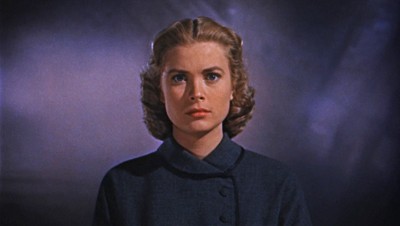
Images in this review were not taken from the Blu-Ray disc.
Jesse Skeen is a life-long obsessive media collector (with an unhealthy preoccupation with obsolete and failed formats) and former theater film projectionist. He enjoys watching movies and strives for presenting them perfectly, but lacks the talent to make his own.
|
| Popular Reviews |
| Sponsored Links |
|
|
| Sponsored Links |
|
|
| Release List | Reviews | Shop | Newsletter | Forum | DVD Giveaways | Blu-Ray | Advertise |
|
Copyright 2024 DVDTalk.com All Rights Reserved. Legal Info, Privacy Policy, Terms of Use,
Manage Preferences,
Your Privacy Choices | |||||||









